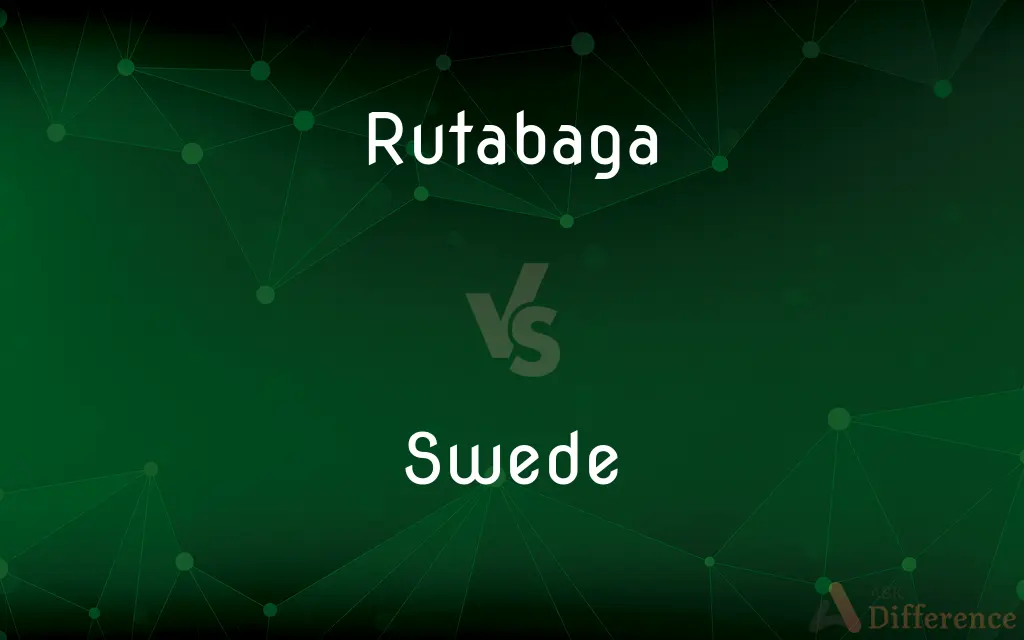Rutabaga vs. Swede — What's the Difference?
Edited by Tayyaba Rehman — By Fiza Rafique — Updated on March 31, 2024
Rutabaga and swede refer to the same root vegetable, known for its purple skin and yellow flesh, differing mainly in regional terminology.

Difference Between Rutabaga and Swede
Table of Contents
ADVERTISEMENT
Key Differences
Rutabaga, a root vegetable also known as swede in many parts of the world, including the United Kingdom and Commonwealth countries, is a cross between a cabbage and a turnip. The terms "rutabaga" and "swede" (short for "Swedish turnip") highlight the vegetable's European origins and its adoption across different cultures. While "rutabaga" is commonly used in the United States and Canada, "swede" is the preferred term in the UK, Australia, and New Zealand.
Both rutabaga and swede describe the same vegetable, Brassica napobrassica, characterized by its large, round shape, purple-tinged skin, and yellow to orange flesh. This biennial plant is grown primarily for its bulbous root, but its leaves can also be consumed as a leafy vegetable. The naming confusion arises from regional differences in English-speaking countries, much like the variations seen with other vegetables and plants.
Nutritionally, rutabagas/swedes are a rich source of vitamins C and E, potassium, and fiber, making them a healthy addition to a variety of dishes. They can be roasted, mashed, boiled, or added to soups and stews, offering a slightly sweet and earthy flavor that complements both meat and vegetarian recipes. This versatility in preparation reflects the vegetable's adaptability in culinary traditions worldwide.
In terms of cultivation, rutabagas are winter vegetables that require a cool climate for optimal growth. They are sown in late spring or early summer and harvested in the fall or early winter, depending on the local climate. This seasonality affects their availability in markets, with peak seasons varying by region.
While the names rutabaga and swede can lead to confusion, understanding that they refer to the same vegetable allows for appreciation of its global culinary uses. The vegetable's role in dishes, from the humble swede mash in the UK to the inclusion in the traditional American Thanksgiving meal, showcases its universal appeal despite regional nomenclature differences.
ADVERTISEMENT
Comparison Chart
Name Origin
American and Canadian English
British English and Commonwealth countries
Also Known As
Swede (in parts of Europe and Commonwealth)
Rutabaga (in North America)
Botanical Name
Brassica napobrassica
Brassica napobrassica
Culinary Uses
Mashed, roasted, added to soups/stews
Same as rutabaga
Seasonality
Grown in cool climates, harvested in fall/winter
Same as rutabaga
Compare with Definitions
Rutabaga
A root vegetable with purple skin and yellow flesh, known for its sweet, earthy flavor.
The rutabaga can be roasted to enhance its sweetness.
Swede
Versatile in cooking, suitable for baking, boiling, and steaming.
Swede can be pureed for a creamy soup base.
Rutabaga
A cross between a cabbage and a turnip.
The rutabaga's history traces back to Europe where it was first cultivated.
Swede
Similar to rutabaga, offering vitamins and minerals.
Swede is a good source of antioxidants.
Rutabaga
Used in various dishes, from soups to mashes.
Rutabaga adds depth to winter stews.
Swede
Same as rutabaga, a nutrient-rich root vegetable with a sweet flavor profile.
Swede is often mashed with carrots and butter.
Rutabaga
Features in Thanksgiving and Christmas meals in North America.
Rutabaga is a traditional side dish at many holiday feasts.
Swede
Preferred term in the UK and other Commonwealth nations.
In Scotland, neeps refers to swede, especially when served with haggis.
Rutabaga
High in vitamins C and E, potassium, and fiber.
Including rutabaga in your diet can boost your vitamin intake.
Swede
A staple in European cuisines, especially during the winter.
Swede features prominently in traditional British and Scandinavian recipes.
Rutabaga
Rutabaga (; North American English) or swede (British English and some Commonwealth English) is a root vegetable, a form of Brassica napus (which also includes rapeseed). Other names include Swedish turnip, neep (Scottish) and turnip (Canadian English, Northern English, Irish English and Cornish English) – however, elsewhere the name "turnip" usually refers to the related white turnip.
Swede
A native or inhabitant of Sweden.
Rutabaga
A plant (Brassica napus var. napobrassica) in the mustard family, having a thick bulbous yellowish root used as a vegetable.
Swede
A person of Swedish ancestry.
Rutabaga
The edible root of this plant. In both senses also called swede, Swedish turnip.
Swede
See rutabaga.
Rutabaga
The swede, or Swedish turnip; the European plant Brassica napus var. napobrassica
Swede
The fleshy yellow root of a variety of rape, Brassica napus var. napobrassica, resembling a large turnip, grown as a vegetable.
Rutabaga
The edible root of this plant
Swede
The plant from which this is obtained.
Rutabaga
The large yellow root of a rutabaga plant used as food
Swede
The turnip.
Rutabaga
A cruciferous plant with a thick bulbous edible yellow root
Swede
The head.
Swede
To produce a low-budget remake of a film without the use of professional actors or filming techniques.
Swede
A native or inhabitant of Sweden.
Swede
A Swedish turnip. See under Turnip.
Swede
A native or inhabitant of Sweden
Swede
A cruciferous plant with a thick bulbous edible yellow root
Swede
The large yellow root of a rutabaga plant used as food
Common Curiosities
Are rutabagas and turnips the same?
No, while related and similar in appearance, rutabagas are larger, have yellow flesh, and a sweeter taste than turnips.
Why are rutabagas called swedes in some countries?
The term "swede" comes from the vegetable's association with Sweden and reflects regional naming conventions.
What's the best way to store rutabagas/swedes?
They should be stored in a cool, dark place or in the refrigerator to maintain freshness for several weeks.
Can rutabagas be eaten raw?
Yes, rutabagas can be eaten raw, often grated into salads for a crunchy, slightly sweet addition.
Can rutabagas be frozen?
Yes, rutabagas can be frozen after blanching, which helps preserve their texture and flavor.
How do you prepare rutabagas for cooking?
Peel the outer skin, then cut into cubes or slices as desired for roasting, boiling, or mashing.
How can I make rutabagas taste better?
Roasting or caramelizing rutabagas can enhance their natural sweetness, making them more palatable.
What dishes are enhanced by adding rutabagas/swedes?
Their sweet, earthy flavor complements soups, stews, mashed vegetable dishes, and roasted vegetable medleys.
Is there a nutritional difference between rutabagas and swedes?
No, since they are the same vegetable, their nutritional profile is identical, offering a good source of fiber, vitamins, and minerals.
What's the difference between rutabagas and carrots?
Rutabagas are root vegetables with yellow flesh and a sweeter, earthier taste than the typically orange and sweeter carrots.
How long do rutabagas last once harvested?
When stored properly, rutabagas can last for several months, making them an excellent winter vegetable.
What are the health benefits of eating rutabagas/swedes?
They are low in calories, high in fiber, and rich in nutrients like vitamin C, potassium, and antioxidants, supporting overall health.
Do rutabagas need to be peeled before cooking?
Yes, the outer skin is thick and should be peeled to reveal the tender, edible flesh inside.
Can diabetics eat rutabagas/swedes?
Yes, with their low glycemic index and high fiber content, rutabagas are suitable for a diabetic diet.
Share Your Discovery

Previous Comparison
Advection vs. Convection
Next Comparison
Netball vs. KorfballAuthor Spotlight
Written by
Fiza RafiqueFiza Rafique is a skilled content writer at AskDifference.com, where she meticulously refines and enhances written pieces. Drawing from her vast editorial expertise, Fiza ensures clarity, accuracy, and precision in every article. Passionate about language, she continually seeks to elevate the quality of content for readers worldwide.
Edited by
Tayyaba RehmanTayyaba Rehman is a distinguished writer, currently serving as a primary contributor to askdifference.com. As a researcher in semantics and etymology, Tayyaba's passion for the complexity of languages and their distinctions has found a perfect home on the platform. Tayyaba delves into the intricacies of language, distinguishing between commonly confused words and phrases, thereby providing clarity for readers worldwide.
















































